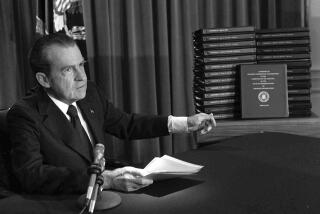CBO Says 1991 Deficit Could Hit $131 Billion : Budget: The amount is almost $70 billion above the legal limit. $28 billion is attributed to additional costs of bailing out S&Ls;.
- Share via
WASHINGTON — Congressional budget experts, adding up for the first time the escalating borrowing needs of the S&L; bailout and other economic factors, estimated Monday that President Bush’s spending plan would leave the federal deficit at $131 billion next year, almost $70 billion above the level projected by the White House.
The Congressional Budget Office predicted that the government will need an extra $28 billion beyond Bush’s estimate for fiscal 1991 to shut down failed thrifts, accounting for 40% of its higher deficit projection.
But, even without the billions in additional federal borrowing to generate “working capital” for the S&L; bailout, Bush’s budget plan would still fall $39 billion short of the $64 billion deficit target called for by the Gramm-Rudman balanced budget law, the CBO estimated.
The White House, which proposed roughly $37 billion in spending cuts and revenue increases in the budget it presented in late January, argues that stronger economic growth and lower interest rates will help bring next year’s deficit to just under the Gramm-Rudman ceiling and will produce a balanced budget in fiscal year 1993.
By contrast, the more pessimistic congressional budget analysts contended that, even if Congress fully adopted President Bush’s budget cuts, the federal deficit would remain a significant drain on the nation’s savings pool through 1994.
The CBO report highlights the chaotic budgetary situation facing lawmakers in the next few years as they seek to meet--at least on paper--the Gramm-Rudman deficit targets while providing sufficient funds to prevent the S&L; cleanup operation from collapsing.
“The budgetary landscape for the next several years is clouded by the cost of the savings and loan crisis, which can wreak havoc with achieving the Balanced Budget Act deficit targets,” the CBO said.
The voracious needs of the Resolution Trust Corp., which is responsible for paying off depositors in failed thrifts, will widen the deficit by at least an extra $32 billion in fiscal 1990, which began last Oct. 1, and $28 billion next year, the CBO report estimates.
But, in later years, as the Resolution Trust Corp. disposes of assets it acquires from the S&Ls;, the flow of funds into the agency will make it easier to reach the deficit targets than previously estimated.
The CBO believes that the Resolution Trust Corp. will run out of money by the end of 1991 and will have to go to Congress for more.
The congressional analysts estimate that $120 billion will be spent from 1990 through 1992 just to pay off depositors at the approximately 300 S&Ls; that the government has already taken over. On top of that, the CBO says, the government will need to take over as many as 300 more thrifts and will need an additional $50 billion or $60 billion to do it, half of which it might eventually get back from asset sales.
The CBO estimate, which officials acknowledge could end up varying markedly if certain assumptions are not accurate, is one of the first efforts by a government office to estimate the full fiscal impact of the bailout.
The Administration has refused to explain how much extra money it will need, the CBO complained.
“The President’s budget provides few details about the assumptions used to estimate spending for the (Resolution Trust Corp.) over the next five years,” the CBO report noted, “and several financial statements normally included are missing.”
As a result of the extraordinary nature of the S&L; bailout, the CBO recommends that the best way to deal with it is to exclude all costs but interest payments from Gramm-Rudman deficit calculations. The White House favors a similar approach, but some critics worry that Congress will take advantage of the complicated situation to fudge on reducing the deficit.
The CBO, fighting a rear-guard action against those in Congress and the White House who want to exclude Social Security from budget calculations, urged lawmakers to continue treating the surplus in the retirement program as a normal budget item.
“The chief importance of the federal deficit is accounting for the government’s use of private saving,” the CBO report states. “When the deficit increases . . . the government is diverting more private savings to public consumption. When the deficit is cut, the government is using less saving. The annual balance in the Social Security programs affects national savings in exactly the same way as the balance in any other government account.”
THREE BUDGET PATHS
Here are the federal deficit and surplus projections, in billions, under current tax and spending policies, under the budget proposed by President Bush and under the Congressional Budget Office’s estimate of the Bush budget.
1991 1992 1993 1994 1995 Current policies -$161 -$124 -$132 -$121 -$110 White House estimate of Bush proposals -61 -24 +20 +64 +111 CBO estimate of Bush proposals -131 -84 -79 -47 -11
Source: Congressional Budget Office
More to Read
Inside the business of entertainment
The Wide Shot brings you news, analysis and insights on everything from streaming wars to production — and what it all means for the future.
You may occasionally receive promotional content from the Los Angeles Times.









